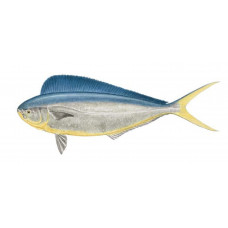Latin name
Coryphaena equiselis
Other names
Mahimahi, blue dolphin, small dolphin, dolphinfish, pompano dolphinfish; French: coryphéne dauphin; Japanese: ebisu-shiira; Portuguese: dourado; Spanish: dorado.
Identification
This species is almost identical to the common dolphin in coloring and general shape, although it has greater body depth behind the head than the common dolphin has and a squarish, rather than rounded, tooth patch on the tongue. There are fewer dorsal rays on the pompano dolphin—48 to 55, versus the common dolphin’s 55 to 65.
Distribution
The pompano dolphin is common throughout the world in tropical seas. In the U.S., it is most commonly found in Hawaii.
Habitat
Prefers surface temperatures above 75 °F. It is considered more oceanic than the common dolphin, but can enter coastal waters.
Size
Average size is 20-24 inches and 4-5 pounds, can grow up to 50 inches.
Life history and Behavior
Little is known about the life history of the pompano dolphin; it is a schooling species that lives in tropical waters, prone to near-surface feeding and attracted to objects. In most behavioral aspects, this fish is similar to the common dolphin.
Food and feeding habits
The pompano dolphin’s diet consists of small fish and squid.
Reproduction
No information
| Classification | |
| Phylum | Chordata |
| Class | Actinopterygii |
| Squad | Carangiformes |
| Family | Coryphaenidae |
| Genus | Coryphaena |
| Species | C.equiselis |
| Features | |
| Conservation status | Least Concern |
| Habitat | Pelagic |
| Life span, years | 4 |
| Maximum body weight, kg | No information |
| Maximum length, cm | 146 |
| Sailing speed, m/s | No information |
| Threat to people | Edible |
| Way of eating | predator |


